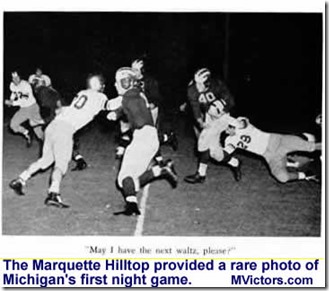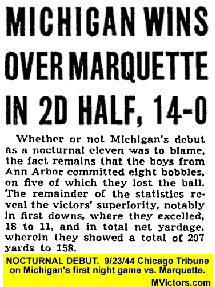1944
Our resident young obsessive WD found a list of all of Michigan's night games, dating back to—wait, 1944? That's right—in 2010 Greg Dooley of MVictors and Greg Kinney, one of the unsung heroes of HTTV (he finds us all those amazing old photos), pulled out details on one of the most unremarked remarkable events in American history.
It's remarkable for the context. This is World War II, remember. The invasion of Europe was stalled while waiting to see if Market Garden could get them into Germany via Holland, and otherwise the lines were about where they'd been entrenched in WWI. On September 6, with decreasing threat of invasion, the United States lifted the blackout rules, to a dim-out. Certainly any meaning of "dim" did not include shining stadium lights on a facility in a coastal city (Milwaukee) with 20,000 live targets in it. Regardless, Marquette apparently played several night games that year and throughout the war—I'd be interested if any historians know why this was cool when so much else in college football was subsided for the war (e.g. 1944 Michigan had to give up its spinning fullback—the QB of the unbalanced single wing—before the Ohio State game because he was called to duty).
The Michigan game being one of them was even weirder, and had to do with Michigan participating in a navy officer cadet program called V-12, and siphoning off V-12s, who couldn't leave the base for more than 48 hours, as football recruits. The time crunch meant an afternoon or night game, so they went night. They also used a highlighter yellow football (you can see it in the photos) that didn't work out so well: one ensuing newspaper article is the first known use of the term "fumbilitis."
BACK TO THE CORNER
Vincent Smith got so sick of MGoBloggers at the last event at Corner Brewery he decided to do it again at the end of the month:
WE WENT TO THE FINALS; WHERE'S THE RECRUITS?
This could be moot in a week (signs are good but when Kentucky's involved I halve all hope) but it does seem Michigan ought to be feeling the effects now of the championship run in the 2014-2016 classes. Walton, Irvin and Chatman were all pretty heralded recruits but their recruitments happened primarily when Zak and Stu were playing, and Michigan was making decisions on whom to pursue for 2015 before the having subs was crazy.
 |
| Things were going great until Kentucky whiffed on their top guys and Calipari started fishing in our waters with bait we won't touch because of rules based in 19th century class ideals. |
Michigan appeared to be in pole position for Devin Booker, Luke Kennard, James Blackmon, and Keita Bates-Diop at various points in those recruitments. In most of those cases, we lost out to a program that could promise as much in the tournament run department and not living like a pauper in the interim.
It sucks that none of those guys were Mitch McGary but McGary is a rare bird. Duke, Kansas, Kentucky, etc. can offer the same or better shot at a national championship, and don't have Michigan's squeamishness about paying them. Remember when Beilein was initially targeting those guys they were 100-250 dudes he saw more than that in.
Once you've blown up into a one-and-done, or at least the one-and-done schools are offering you the one-and-done package, the prestige of your degree matters way less than the degree to which your school is willing to accept the fact that you're there to try out for an NBA contract, and act accordingly. Blame the NBA's rule—created to prevent their teams from investing in busts before they've played against higher competition—for turning an age-old hypocrisy into a blatant thing.
It's not a sure thing—did you think we'd be here with Brown?—and once you're past the NBA locks Michigan can play ball. The difference between a top ten pick and, say, Caleb Swanigan, is an important one for the relatively clean programs. MSU got a top-20 post player because Tom Izzo has a long record of developing post players, and if you're starting at #20 your coaching is the difference between 1st or 2nd round grade in one or two (or four) years. If you watched that saga, you saw Purdue start in good shape and get strung along as the cute local school by the end. Beilein looks pretty good for any NBA wing or point guard—we'll never be Kentucky but we're probably not losing guys to Purdue, and that's something.
Etc. Update on 2015 non-conf opponents' springs. VT's secret to beating Ohio State' with 46 Bear concepts is cool, but outdated; Alabama tried that and got Vince Lombardi'd in the face. Worst damn band in the land. If you wanna meet the MGoDog he'll be at softball this weekend.
Your Moment of Zen:
How you like me now?
Highlights from 1948 Rose Bowl
Every five years or so, a group of old Michigan players from mid-1940s would gather to share old stories and relive the camaraderie of one of the closest teams to ever put on the winged helmet. The team featured the All-American backfield duo of Bob Chappuis and Bump Elliott, not to mention Howard Yerges, Bob Mann, and future All-Americans Alvin Wistert, Pete Elliott, Dick Rifenburg, and Robert Wahl. But when you ask the history guys who really made that team go, their answer is always the same guy, and not one of the above. He was also, coincidentally, the guy organizing the reunions.
As they last met in 2008, 2013 was supposed to be the next such get-together. Some of the guys are still out on the golf course, but the years have dealt the losses to these men that their 1946-'49 opponents never could, and of those that remain to us, too few can responsibly make the journey for a 2013 reunion. So we'll have it here instead, as MGoBlog had the opportunity to interview the man at the heart of one of Michigan's all-time greatest teams, spinning fullback Jack Weisenburger.
Last week I had the opportunity to spend a short time speaking with Jack on the phone about his time at Michigan, from his recruitment to the changes he witnessed in wartime, to the team. His story and theirs, after the jump.




15